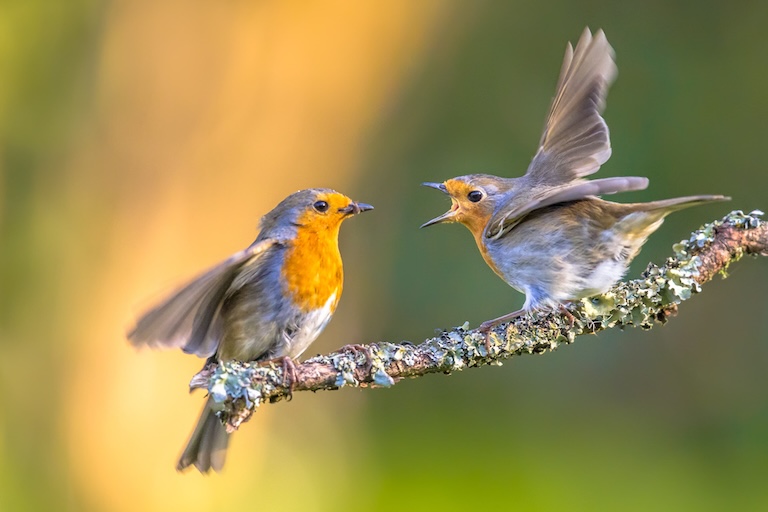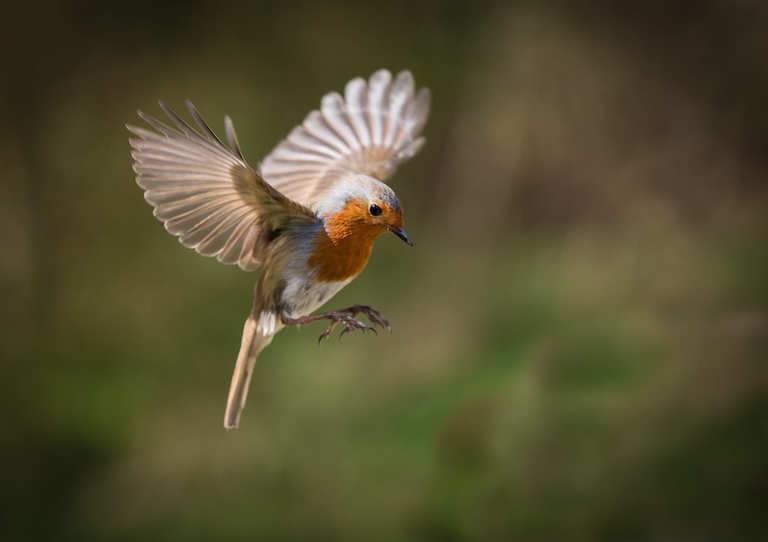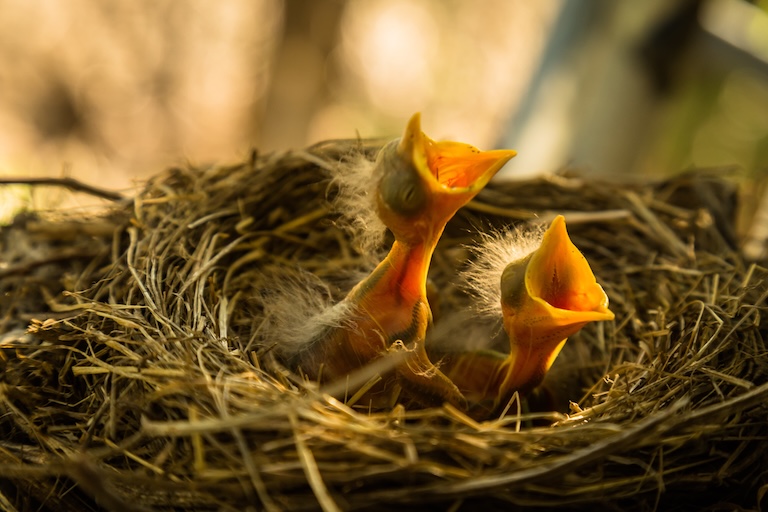European Robin Profile
A lot of what we consider the tranquillity of the countryside is the threatening soundscape of a hundred thousand Passerine war cries; countless territorial little birds, all yelling at one another not to dare approach and no doubt using language that we would not absorb so readily if we knew what it meant.
Most species are all talk, no trousers, but sometimes the smallest are the most committed to backing up what they say. The European robin was never convinced about its diminutive size and maintains that it’s the most powerful bird in the Kingdom. It’s such a tough little archosaur that even Winter can seldom displace it.

European Robin Facts Overview
| Habitat: | Wooded edges, urban gardens |
| Location: | Much of Eurasia and North Africa |
| Lifespan: | 19 years |
| Size: | Around 14cm (5.5 in) tall, 22cm (8.5 in) wingspan |
| Weight: | Up to 22g |
| Colour: | Brown to reddish-brown, distinctive red breast |
| Diet: | Insects, worms |
| Predators: | Humans, domestic cats, and sometimes the young raptors |
| Top Speed: | Unknown |
| No. of Species: | 1 |
| Conservation Status: | Least Concern (IUCN) |
Robins exhibit some of the most densely-packed characters of any animal, being relatively tiny flycatchers with a boldness that comes from not taking any crap from anybody.
They’re well known to gardeners for perching nearby, taking advantage of the invertebrates upturned by the garden fork, and the two species have formed quite an affinity for one another.
Their tendency to stay put when Winter comes along further endears us to them, and they’ve been a part of local folklore across their range in Europe.
Interesting European Robin Facts
1. They’re flycatchers
Old-world flycatchers are awesome little birds from the Muscicapidae family and are commonly found across Africa, Europe and Asia. The European robin is one of the larger in the family, but they get up to about 22cm tall.
They come in all shapes and colours, but the robin is certainly one of the most distinctive with the red chest that inspired legends across Europe. Some say the robin went over to pay his respects to Jesus on the cross and got some of the blood on him, but this seems highly unlikely.
Others say it’s from being flamed in purgatory when fetching water for some of the souls kept there. This is equally unlikely, but it goes to show the respect that people have for the bird that it’s described as kind and considerate in this way.
In reality, the red pigment comes from the bird’s diet, as birds can’t manufacture it on their own. Carotenoids are converted to red in many species to show that the host has a healthy diet and is therefore quite successful in life. This suggests it’s a good choice for a mate, and since females are the sexual selectors in these birds, it’s the males who sport the reddest of breasts.
2. They’re territorial
But male robins are more than a nice set of breasts. They can be ferocious defenders of their territory too.
Much of their daily shouting is about keeping other birds off their turf, but if this doesn’t work they will get into scraps too.
Wrestling is common among conspecifics, and the winner is the one who can pin down their opponent. But it’s able to also chase much larger birds away with its persistent attacks.
Interestingly, while many birds are aggressive during mating periods, robins are just like this all the time, and is therefore not mediated as much by increases in androgens like testosterone, as it is in other birds.
Still, their hormones do play a role, and the “stay away” calls are less loud and powerful during non-breeding periods. 1 2

3. They do migrate
A characteristic trait of robins in many populations is their sedentary nature. When Winter approaches and many other bird species leave for their second homes, Robins like to stay put. This makes them an iconic Winter species across much of Europe, and they show up a lot on Christmas cards as a result.
But the far North is a little too chilly even for this tough little bird. Robins have an excellent quantum magnetic compass built into their faces, and this lets them find their way out of their territory and back as the seasons change, in regions where they do migrate.
It is found across Europe, east to Western Siberia and south to North Africa; it is sedentary in most of its range except the far north. Females are much more likely to migrate than males, and other factors like age and body size also affect where the robins will spend their Winters.
Larger birds tend to get the best choice of habitat and are therefore healthier in general. 3
4. Sometimes they can’t take off
Before migrating, it’s important to stock up on food, but this can be a vulnerable time for a small bird, as the fuel they need to take on can slow their ability to take off.
While their speed isn’t greatly affected, the angle at which they can get up into the air is. So, in case you were wondering, attacks on a fully laden (European) robin are best timed right before their migration. 4
5. They make sweet little nests
Tiny birds usually make cute nests, but the nest of a robin is particularly neat and tidy. It’s a delicate little cup of moss and grass, with a comfort layer made from feathers, hair, or very fine, fluffy grasses.
Robins seem to put a lot of pride into their work (the Hamerkop being at the other end of this spectrum) and build these tiny sanctuaries in a mat of leaves inside hedges, tree cavities, or grass banks, or anything sufficiently sheltered.
It’s not uncommon to find a robin nest inside a garage, secreted in an old kettle, barbecue or bicycle helmet.
Inside there will be up to seven eggs, and fledglings will start to get their characteristic vests after a few months.

6. They’re target practice for young raptors
The majority of a robin’s diet is made of invertebrates, but they are strong enough to take the occasional tiny vertebrate too. Still, they’re at the smaller end of the spectrum and are themselves prey for much larger birds.
Robins are a common practice animal for raptors in training and juvenile predatory birds will hunt them while they’re still small enough to value the meal. 5
7. They’re doing great!
Robins don’t have a lot to contend with in general, though, and the species as a whole is really doing quite well.
The IUCN Red List has this species listed as Of Least Concern, but this doesn’t tell the full story.
Global populations combined are thought to be upwards of 300,000,000 mature individuals and they’re actually on the rise.
Their major threats include harsh Winters, and with average temperatures rising in Europe, this is likely contributing to their increasing numbers.
European Robin Fact-File Summary
Scientific Classification
| Kingdom: | Animalia |
| Phylum: | Chordata |
| Class: | Aves |
| Order: | Passeriformes |
| Family: | Muscicapidae |
| Genus: | Erithacus |
| Species: | Rubecula |
Fact Sources & References
- David Element (2018), “European Robin Erithacus rubecula male singing his territorial song”, YouTube.
- Hubert Schwabl (1991), “Territorial aggression and song of male European robins (Erithacus rubecula) in autumn and spring: Effects of antiandrogen treatment”, Science Direct.
- Paulo Catry(2004), “Winter segregation of migrant European robins Erithacus rubecula in relation to sex, age and size”, Nordic Society Oikos.
- Johan Lind (199), “Reduced take-off ability in robins (Erithacus rubecula) due to migratory fuel load”, Springer Link.
- “European Robin”, Oiseaux Birds.
